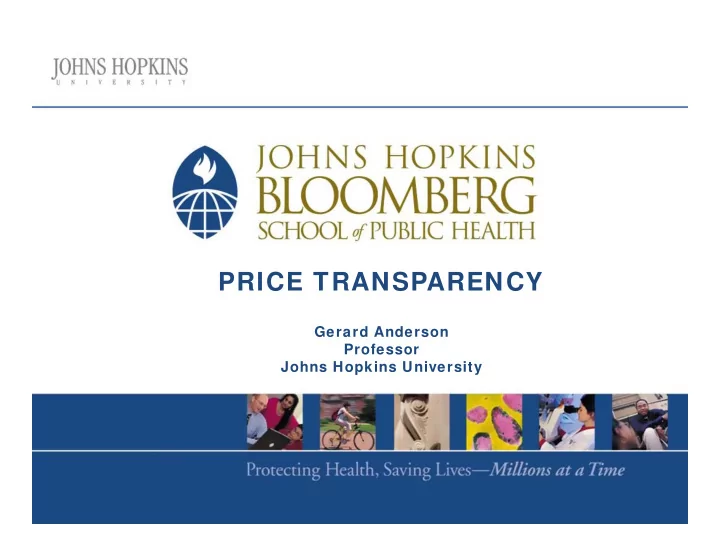

PRICE TRANSPARENCY Gerard Anderson Professor Johns Hopkins University
Full Disclosure • For the past 8 years, I have been an expert witness in many court cases where the issue was the reasonable amount the hospital should receive for treating a class of patients Started with Congressional testimony in 2004 Health Affairs – ”From Soak the Rich to Soak the Poor” No cases in NY – and not looking for more business! • In these cases a key issue was price transparency Hospitals wanted the patients to pay full charges since there was no established agreement Uninsured; Amish; casualty, worker compensation, auto and international insurers; high deductible health plans
My view - A Reasonable Amount is the Sum Of What Medicare pays + The amounts private insurers typically pay above what Medicare pays An additional allowance for the private insurers that cannot get the average A prompt pay discount The current national reasonable rate is Medicare + 41%
How Is This Related To Price Transparency? • Hospital typically argued that patients without the benefit of a pre existing agreement should pay full charges • If price transparency showed patients the full charge master file rates, would this constitute true price transparency? Yes, it is what each hospital charges No, it is not close to what the hospital actually receives Charges are typically 4.5 times costs and 4.0 times average payments
Most Studies Have Shown Minimal or No Impact of Price Transparency on Consumer Behavior • Knowing what a hospital charges • People purchase care from for a service provides little physicians and other clinicians, so information because most people you need to look at the total do not pay charges payment, not just the hospital bill
Patients want to know actual amount they will pay for a specific procedure, not the charge Patients want to Price transparency know the total does not work for payments for all the emergencies – can’t services including comparison shop physician and other services What Is Needed For Real Price Transparency? 6
Building Blocks for Price Transparency • Bundled payments – The total • Comparable services – in order to amount they will need to pay from compare prices the services must be all providers, not just the amount defined in exactly the same way from the hospital The only viable option may be DRGs
More building blocks Include all discounts the Most patients see multiple insurer is receiving – if I MDs during the hospital visit have coinsurance, I want to pay 20% of the bill the insurer pays, not 20% of the Which physicians are in my amount charged network Which physicians accept assignment Without this information you do not know the amount you will pay for MD services 8
In Summary Without this you are not Price transparency comparing the total requires publishing amount the patient will pay for hospital care A reasonable rate (not charges) For all services (not just hospital) In a bundle (not individual line items) that can be compared Takes into account all discounts the insurer gets Identifies who is in network and who accepts assignment 9
Recommend
More recommend